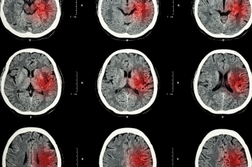
The ATACH2 Trial
What's it about?
What did they do?
Their primary outcome was the level of death or disability at 3 months, as defined by the modified Rankin scale. Secondary outcomes included the degree of haematoma expansion at 24 hours, quality of life (as assesses by the EQ-5D questionnaire) and the incidence of complications.
What did they find?
However, analysis of the outcomes showed no difference in the primary outcome. The rate of death or disability was 38.7% in the intensive treatment arm compared with 37.7% in the standard treatment arm. Even with some statistical manipulation to ‘adjust’ for potential influencing factors (age, GCS, intraventricular extension) there wasn’t even a hint at any sort of significant difference in 3 month outcome.
However, two factors of note were different between the groups: the intensive treatment arm showed a tendency for reduced haematoma expansion (relative risk 0.78, CI 0.58-1.03), and also had a higher rate of adverse incidents over the 3 months (25.6 vs 20.0%).
Is it any good?
Perhaps the first interesting point to discuss was the discrepancy in the treatment failure rate. This was basically the number of patients that were allocated to on BP target but were unable to achieve it within the initial time target (primary failure), or to maintain it over the 24 hours (secondary failure). Unsurprisingly, both of these were higher in the intensive treatment group, with primary and secondary failure occurring in 12.2% and 15.6% of these patients respectively, compared to just 0.8% and 1.4% in the standard treatment arm. This has the potential to confound the results and conclusions to some degree, as it meant that there was a not insignificant part of the ‘intervention’ arm that didn’t adequately receive the intervention.
A further observation provides some pause for thought when analysing the results. Though the groups appear to be well differentiated from a statistical perspective, the difference between the mean systolic blood pressures is only just over 12 mmHg. Now this is still a difference, but it makes you wonder (especially when combined with the treatment failure rate) as to whether the overall difference between the 2 groups was less than appears at first glance.
However, perhaps the most interesting point arises when we look at the nature of the patient characteristics. The majority of these patients (55%) were GCS 15 at presentation. Similarly, the incidence of ‘poor outcome’ was notably less than the 60% the authors anticipated. This raises questions about whether this is the correct patient population to be looking at for this, and whether the aggressive lowering of blood pressure is not appropriate for these patients.
Final thought
Thanks again for reading, and I must once again thank everyone at our journal club for all of their contributions. As always please leave your thoughts on the topic. I’d also really recommend checking out The Bottom Line website through the link below for another great review of this paper (as always).
BW
Tom Heaton
References & Links
- Qureshi A Et al. Intensive blood-pressure lowering in patients with acute cerebral haemorrhage (ATACH2). NEJM. 2016.
- Anderson C Et al. Rapid blood-pressure lowering in patients with acute intracerebral haemorrhage. NEJM. 2013. 368:2355-2365.
- Wong A, Chambler D. Summaries: ATACH2. Thebottomline.org.uk. 2016.
 RSS Feed
RSS Feed
